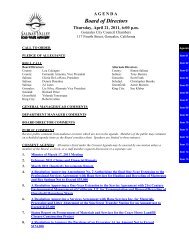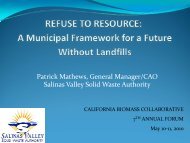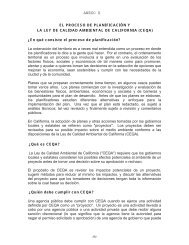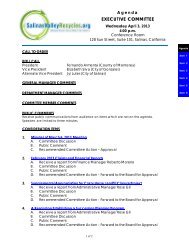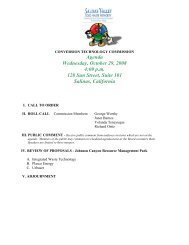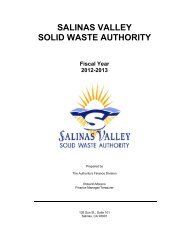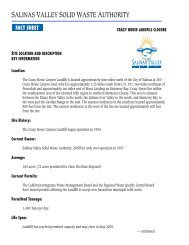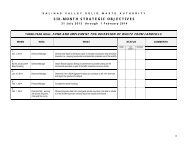revised final closure plan - Salinas Valley Solid Waste Authority
revised final closure plan - Salinas Valley Solid Waste Authority
revised final closure plan - Salinas Valley Solid Waste Authority
You also want an ePaper? Increase the reach of your titles
YUMPU automatically turns print PDFs into web optimized ePapers that Google loves.
Revised Final Closure Plan July 2010<br />
Crazy Horse Sanitary Landfill -5- 103-97133<br />
area requiring <strong>closure</strong> is approximately 66 acres. A schedule for CHLF <strong>closure</strong> activities based on<br />
<strong>closure</strong> construction material quantities and deployment rates is discussed in Section 2.6.<br />
The remaining landfill areas to be closed are identified below. The <strong>closure</strong> will take place in four<br />
general phases. These phases in sequence are:<br />
I. Southern slopes to the canyon floor.<br />
II. Western topdeck and sideslopes<br />
III. Eastern topdeck and sideslopes.<br />
IV. Equipment parking and a recycling center area.<br />
The first phase, the southern slopes, must be closed first to provide the necessary drainage<br />
conveyance structures required to control stormwater discharge from improved surfaces in the other<br />
phases as the site is closed. The second and third phases are depicted on Figure 4 as the west and east<br />
sections of the currently active landfilling area. It is necessary to separate the topdeck area of the<br />
CHLF into separate <strong>closure</strong> phases to maintain LFG control in the primary waste mass during <strong>closure</strong><br />
as discussed in Section 2.21. Active LFG control is a component of the groundwater Corrective<br />
Action Program (CAP) so this function must be maintained during <strong>closure</strong> construction.<br />
The fourth phase is the area currently used for recycling and maintenance activities, located to the<br />
east of the active landfill and north of Module 1. This area was determined to be within the “Subtitle<br />
D landfill footprint” as reported in 1993 and included within the limits of waste as shown on Figure 4.<br />
Final Cover Extension. The SVSWA investigated the potential for waste outside the limits of the<br />
Module 1 <strong>final</strong> cover system with a series of test pits in 2007. An extension to the Module 1 <strong>final</strong><br />
cover system is required due to the presence of waste discovered beyond the perimeter road (ref.<br />
Figure 4). The extent of <strong>final</strong> cover begins near the flare station to past the visually obvious locations<br />
of perimeter road subsidence, encompassing approximately 0.34 acres. This work will include<br />
rebuilding the perimeter road to re-establish positive drainage to the catch basin at the end of the<br />
perimeter road.<br />
2.4 Monitoring and Control Systems<br />
27 CCR 21790(b)(4) and 20180<br />
The current monitoring and control systems at the Crazy Horse Sanitary Landfill consist of leachate<br />
monitoring and control system (ref. Figures 6 and 7), a groundwater monitoring system (ref. Figures<br />
8, 9, and 10), a groundwater extraction and treatment system, a stormwater discharge monitoring<br />
system, and an LFG monitoring and control system (ref. Figure 11). The current monitoring and<br />
control systems were described in the following sections of the JTD (Vol. 1):<br />
• Section 5.6 - Leachate Monitoring and Control System<br />
• Section 6.3.1 - Groundwater Monitoring System<br />
• Section 3.5.8 - Groundwater Extraction System<br />
• Section 6.3.3 - Stormwater Discharge Monitoring System<br />
• Section 6.3.4 - Landfill Gas Management System<br />
Golder Associates



